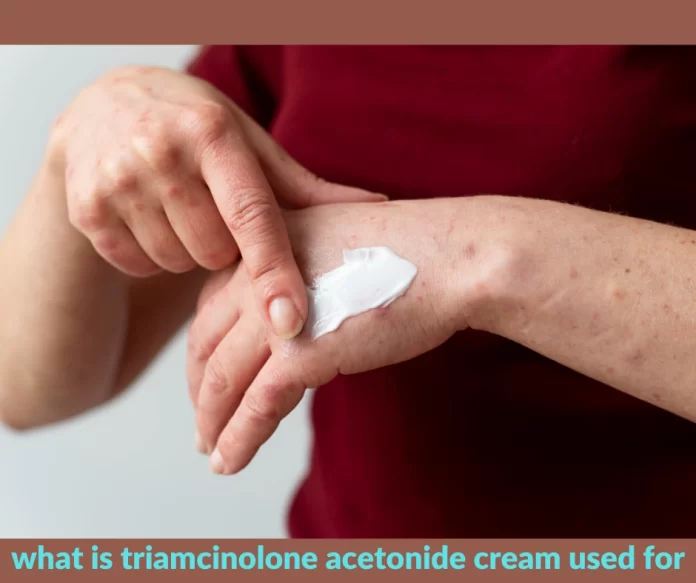Triamcinolone acetonide cream is a topical medication used to treat various skin conditions, such as inflammation, itching, and allergic reactions. It belongs to the class of corticosteroids, specifically synthetic glucocorticoids, which are powerful anti-inflammatory agents. Triamcinolone acetonide cream is available by prescription and is applied directly to the skin to provide localized relief from inflammation and related symptoms.
It’s important to use triamcinolone acetonide cream as directed by a healthcare professional, as overuse or improper use of corticosteroids can lead to side effects such as skin thinning, changes in skin color, and other potential complications. Long-term use or excessive application of potent corticosteroids should be done under medical supervision to minimize risks and achieve optimal therapeutic results.
Table of Contents
Medical Applications and Uses of Triamcinolone Acetonide Cream:
Triamcinolone acetonide cream is a versatile topical medication widely used in dermatology and other medical fields to address a range of skin conditions and inflammatory reactions. Its primary applications include treating various skin conditions and providing relief from itching, redness, and swelling associated with inflammation.
- Skin Conditions: Triamcinolone acetonide cream is effective in managing several skin conditions, including:
- Eczema (Atopic Dermatitis): This chronic skin condition is characterized by red, itchy, and inflamed skin. Triamcinolone acetonide cream can help alleviate itching, reduce inflammation, and improve the appearance of eczematous skin.
- Psoriasis: Psoriasis leads to the rapid buildup of skin cells, causing scaling, redness, and discomfort. Triamcinolone acetonide cream helps reduce the inflammation and scaling associated with psoriasis lesions.
- Contact Dermatitis: This condition arises from skin contact with allergens or irritants, resulting in redness, itching, and inflammation. Triamcinolone acetonide cream can soothe the affected skin and minimize these symptoms.
- Seborrheic Dermatitis: Characterized by flaky, scaly skin, especially on the scalp and face, this condition can be managed with the anti-inflammatory properties of triamcinolone acetonide cream.
- Allergic Reactions: Triamcinolone acetonide cream can provide relief from the itching, redness, and swelling caused by allergic reactions to substances like insect bites and certain plants.
- Lichen Planus: This inflammatory condition affects the skin, mucous membranes, and sometimes nails, causing itchy, reddish-purple bumps. Triamcinolone acetonide cream can help reduce inflammation and itching.
- Inflammation: Triamcinolone acetonide cream’s anti-inflammatory properties make it effective in reducing the symptoms associated with various forms of inflammation. It can be used to treat conditions like:
- Localized Inflammation: The cream is applied directly to the affected area, targeting inflammation, which may result from skin conditions, irritants, or allergic reactions.
- Joint and Muscular Inflammation: In certain cases, triamcinolone acetonide cream can be used to alleviate inflammation and discomfort caused by conditions such as arthritis or minor sprains.
Effectiveness in Reducing Itching, Redness, and Swelling:
Triamcinolone acetonide cream’s effectiveness in reducing itching, redness, and swelling is attributed to its anti-inflammatory and immunosuppressive properties. When applied to the skin, it works by suppressing the body’s immune response, thereby mitigating inflammation and the associated symptoms. It helps to:
- Relieve Itching: Triamcinolone acetonide cream can provide rapid relief from itching, a common symptom in various skin conditions, by reducing the inflammatory response that triggers itching sensations.
- Reduce Redness: The cream’s anti-inflammatory action helps minimize the redness associated with skin conditions, providing a more even and natural skin tone.
- Alleviate Swelling: By reducing inflammation, the cream helps decrease swelling and discomfort, promoting improved comfort and appearance.
It’s important to note that while triamcinolone acetonide cream is effective, its use should be under the guidance of a healthcare professional. Proper diagnosis, dosage, and duration of treatment are crucial to achieving the best therapeutic outcomes and minimizing potential side effects.
Dermatological Conditions and Triamcinolone Acetonide Cream:
Triamcinolone acetonide cream plays a pivotal role in addressing a variety of dermatological conditions, offering relief from symptoms and improving the quality of life for individuals experiencing discomfort. Here’s how it’s applied to manage specific skin issues:
- Eczema (Atopic Dermatitis):
Triamcinolone acetonide cream is applied to eczema-affected areas to:
- Reduce Inflammation: The cream’s anti-inflammatory properties soothe redness and inflammation, providing relief from the characteristic itchiness and discomfort of eczema.
- Alleviate Itching: By suppressing the immune response that triggers itching, the cream helps individuals experience less scratching, leading to improved skin integrity.
- Dermatitis (Contact and Seborrheic):
Triamcinolone acetonide cream addresses different forms of dermatitis by:
- Calming Irritation: In cases of contact dermatitis caused by allergens or irritants, the cream reduces redness and irritation.
- Minimizing Scaling: For seborrheic dermatitis, the cream helps reduce the flakiness and scaling of affected areas.
- Skin Rashes:
Triamcinolone acetonide cream effectively manages various types of rashes, such as:
- Allergic Rashes: The cream eases itching, redness, and swelling caused by allergic reactions, promoting quick relief.
- Inflammatory Rashes: It helps alleviate discomfort associated with inflammatory skin rashes, including those resulting from irritants.
Real-World Examples:
- Evelyn’s Eczema Relief: Evelyn, a 7-year-old girl, had been struggling with severe eczema on her arms and legs. Triamcinolone acetonide cream was prescribed by her dermatologist. After a few days of consistent application, Evelyn’s skin showed visible improvement. The cream’s anti-inflammatory action reduced redness and itching, allowing Evelyn to sleep better at night and participate in activities without discomfort.
- Chris’s Contact Dermatitis: Chris, a landscaper, developed contact dermatitis after coming into contact with certain plants. His skin was red, itchy, and irritated. Triamcinolone acetonide cream helped soothe the inflammation and provided relief from itching. With proper application and avoiding contact with irritants, Chris’s skin gradually healed, enabling him to continue his work with less discomfort.
- Amy’s Allergic Reaction: Amy experienced a severe allergic reaction after a mosquito bite, leading to an itchy and swollen area on her arm. Triamcinolone acetonide cream quickly reduced the swelling and itching, allowing the bite to heal without further complications.
Proper Usage and Considerations for Triamcinolone Acetonide Cream:
- Prescription Required: Triamcinolone acetonide cream is available only with a prescription from a healthcare professional. Do not use it without proper medical guidance.
- Follow Medical Instructions: Always use the cream exactly as prescribed by your healthcare provider. Follow the recommended dosage, application frequency, and treatment duration.
- Clean and Dry Skin: Before applying the cream, ensure that the affected area is clean and dry. Gently wash and pat the area dry before applying a thin layer of the cream.
- Avoid Sensitive Areas: Avoid applying the cream to sensitive areas of the face, near the eyes, or on mucous membranes unless specifically directed by your doctor.
- Hands Should Be Clean: Wash your hands thoroughly after applying the cream, unless your hands are the treated area. This prevents unintentional transfer of the medication to other parts of your body.
- Do Not Bandage Tightly: Unless directed by your healthcare provider, avoid tightly bandaging or covering the treated area. This can increase the absorption of the medication into your bloodstream.
- Gradual Discontinuation: If your healthcare provider advises discontinuing the cream, follow their instructions. Abruptly stopping its use can lead to a rebound effect or worsened symptoms.
- Do Not Share Medication: Triamcinolone acetonide cream is prescribed specifically for you based on your condition. Do not share it with others, even if they have similar symptoms.
- Monitor for Side Effects: While side effects are uncommon with topical use, keep an eye out for any unusual skin reactions, irritation, or allergic responses. If you notice any adverse effects, contact your healthcare provider.
- Consult Your Doctor: If you have questions about the cream, its usage, potential interactions, or any concerns, consult your healthcare provider for accurate and personalized guidance.
What Is Triamcinolone Acetonide Cream Used For:
Triamcinolone acetonide cream is used to treat various dermatological conditions and inflammatory issues, including but not limited to:
- Eczema (atopic dermatitis)
- Psoriasis
- Contact dermatitis
- Seborrheic dermatitis
- Allergic reactions
- Inflammatory skin rashes
- Joint pain and arthritis-related inflammation
Benefits and Precautions of Triamcinolone Acetonide Cream:
Benefits:
- Anti-Inflammatory Action: The cream’s primary benefit lies in its potent anti-inflammatory properties. It effectively reduces redness, itching, swelling, and discomfort associated with skin conditions and localized inflammation.
- Targeted Relief: Triamcinolone acetonide cream is applied directly to the affected area, providing localized relief without affecting other parts of the body. This localized application helps minimize potential systemic side effects.
- Quick Relief: Its rapid onset of action means you can experience relief from itching, redness, and swelling relatively quickly after application.
- Enhanced Quality of Life: By addressing discomfort and inflammation, the cream can significantly improve your quality of life, allowing you to carry out daily activities with greater ease and comfort.
- Versatile Applications: Triamcinolone acetonide cream is suitable for treating a range of skin conditions, from eczema and psoriasis to allergic reactions and various forms of dermatitis.
Precautions:
- Prescription Requirement: This cream requires a prescription from a healthcare professional. Do not use it without proper medical guidance.
- Medical Supervision: Use the cream under the supervision of your healthcare provider. They will determine the appropriate dosage, frequency, and treatment duration based on your condition.
- Avoid Long-Term Use: Prolonged and excessive use of corticosteroid creams can lead to skin thinning, changes in skin color, and other side effects. Follow your healthcare provider’s recommendations and treatment plan.
- Side Effects: While side effects are rare with topical use, they can include skin irritation, burning, and allergic reactions. If you notice any adverse reactions, consult your healthcare provider.
- Avoid Sensitive Areas: Avoid applying the cream near the eyes, on the face, or on mucous membranes, unless specifically directed by your healthcare provider.
- Gradual Discontinuation: If your healthcare provider advises discontinuing the cream, follow their instructions. Abruptly stopping its use can lead to a rebound effect.
- Underlying Conditions: Inform your healthcare provider about any underlying medical conditions or ongoing treatments, as they may affect the suitability of using triamcinolone acetonide cream.
- Pregnancy and Breastfeeding: If you are pregnant or breastfeeding, consult your healthcare provider before using the cream to ensure its safety for you and your baby.
- Children and Elderly: Special considerations may apply to the use of the cream in children and elderly individuals. Consult your healthcare provider for guidance.
In conclusion, triamcinolone acetonide cream is a valuable medication with a versatile role in managing a wide range of dermatological conditions and inflammatory issues. Its potent anti-inflammatory properties make it effective in reducing redness, itching, swelling, and discomfort associated with skin conditions such as eczema, psoriasis, dermatitis, and various types of rashes. Additionally, it provides targeted relief for localized inflammation caused by arthritis, joint pain, and allergic reactions.
However, the significance of consulting a healthcare provider before using triamcinolone acetonide cream cannot be overstated. Their expertise ensures accurate diagnosis, tailored treatment plans, and consideration of potential allergies, interactions, and underlying health concerns. Through informed collaboration with healthcare professionals, individuals can harness the benefits of triamcinolone acetonide cream while minimizing risks and optimizing their overall well-being.
Ultimately, triamcinolone acetonide cream serves as a valuable tool in the realm of dermatological care, promoting relief, comfort, and improved quality of life for those dealing with various skin conditions and inflammatory challenges.











![How to Unlock Bootloader without PC On Android [2022]](https://cracktech.net/wp-content/uploads/2019/02/unlock-boot.png)